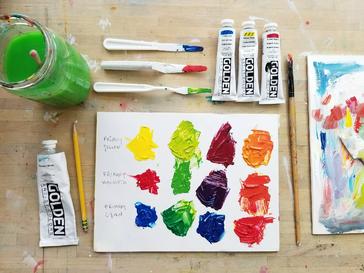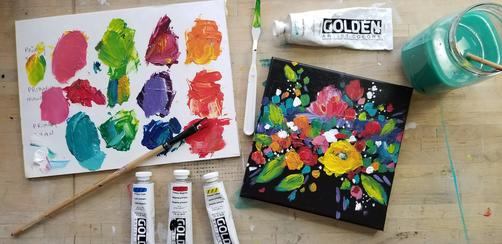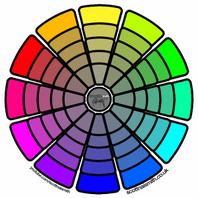Color Mix Like a Pro Using Only Three Colors

Yes, it's true, mix like a pro using just three colors plus white!
Over the years I have found myself naturally limiting my palette as I mix my own colors more often.
Narrowing my palette to my few favorite colors like Quinacridone Magenta, Hansa Yellow medium, Green-Gold, Turquoise, Payne's Grey, and Permanent Violet hue - all by Golden Acrylic Paints - I have simply found I don't need every color. And with the growth of Color Crush Creative, I have been even more aware of color mixing and how to arrive at the desired colors for each palette. But this learning plays with just three colors has brought color mixing to a new level.
A NEW COLOR WHEEL
Using only Primary Cyan, Primary Yellow, and Primary Magenta, I created a wide range of beautiful, vibrant colors. A traditional color wheel has us using cadmium red, yellow, and ultramarine blue, but after much research and a whole lot of time playing with paint, I have come to agree with the Modern Experts that those wishing for a bright, color-popping palette, these new primary colors are the way to go.
The best way to learn is to do. Start by adding the three basic colors mentioned above to your palette. For each secondary color, mix three varying hues. For example, using cyan and yellow I made the green variations. I used mostly yellow and a touch of cyan to make the lightest hue, and then adjusted the amount of cyan just a little more to make the darker shades of green. Cyan has a stronger tinting strength, so you only need to start with a little bit when mixing with yellow. Next mix three hues of violet and three hues of orange in the same manner that you mixed green. Viola! Your first set of mixed colors using just three tubes of paint.

YOUR TURN: LIMIT YOUR PALETTE
After you have mixed up the basic secondary colors, it's time to dig deeper. It's your turn to see what will happen next as you mix these colors in new and different ways. There is no better way to learn than to play! Try out a few of these ideas:
🔹 Make the traditional primary colors red and blue by mixing magenta with a touch of yellow or cyan with a touch of magenta - did you know you could mix red and blue?!
🔹 Mix cyan and medium green with a bit of white to make a beautiful blue-green. You can make your own teal!
🔹 Add white to any violet to get lavender. Can you make the Pantone color of the year - ultraviolet (purple)?
🔹 Try mixing a brown by using three primaries or three secondaries. Add white if you need to.
🔹 Tone down the electric green by adding a touch of magenta or orange and see if you can come up with a more natural shade of green.
🔹 Adding white to the darker orange could make a beautiful coral color
🔹 Can you make grey? Mixing colors opposite on the color wheel (cyan and orange, magenta and green, yellow and violet) plus white will make beautiful, rich grey tones
🔹 Or try to make a perfect tint of pink with red or magenta.
🔹 Try your combination and share your results.

GET YOUR SUPPLIES HERE:
Golden Heavy Body Acrylic Paint, 2oz. Tube, Primary Cyan
Golden Heavy Body Acrylic Paint, 2oz. Tube, Primary Yellow
Golden Heavy Body Acrylic Paint, 2oz. Tube, Primary Magenta
Golden Heavy Body Acrylic Paint, 2oz. Tube, Titanium White
Golden Fluid Acrylic Paint, 4oz. Bottle, Primary Cyan
Golden Fluid Acrylic Paint, 4oz. Bottle, Primary Yellow
Golden Fluid Acrylic Paint, 4oz. Bottle, Primary Magenta
Liquitex Professional Gesso, 32oz bottle
(I always use this for my fluid white)
One of my favorite atmospheric, abstract artists is Scott Naismith and he paints using colors that are out of this world. He describes color theory better than I ever could. Scott made a handy CYM color wheel to emphasize the colors we should be called "primary" colors.
And, of course, you can find a whole series that he created on YouTube about color theory.


